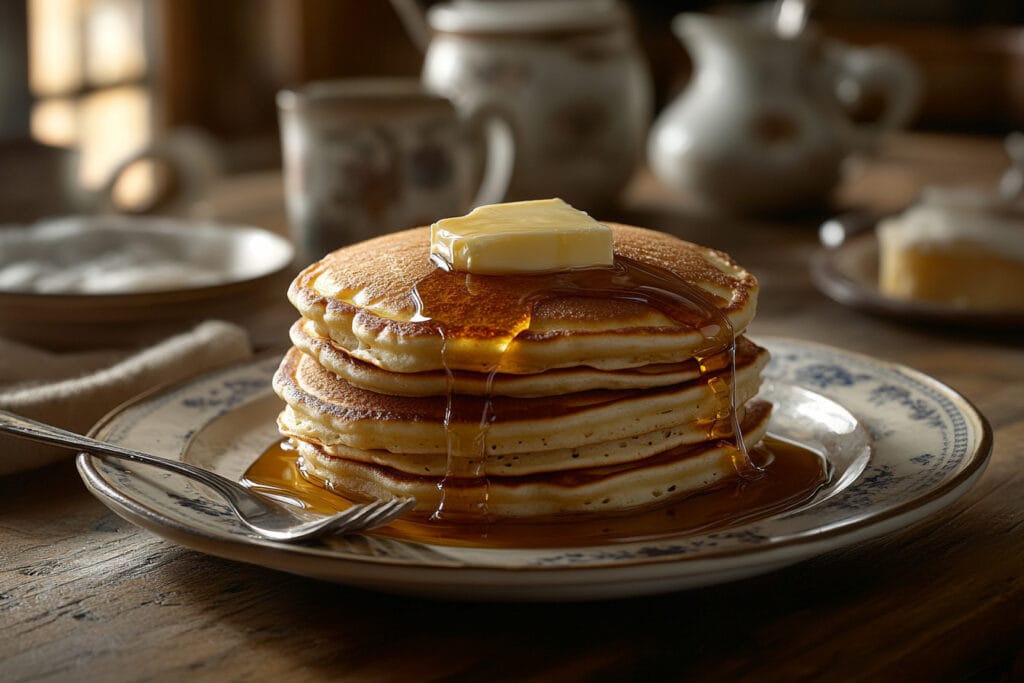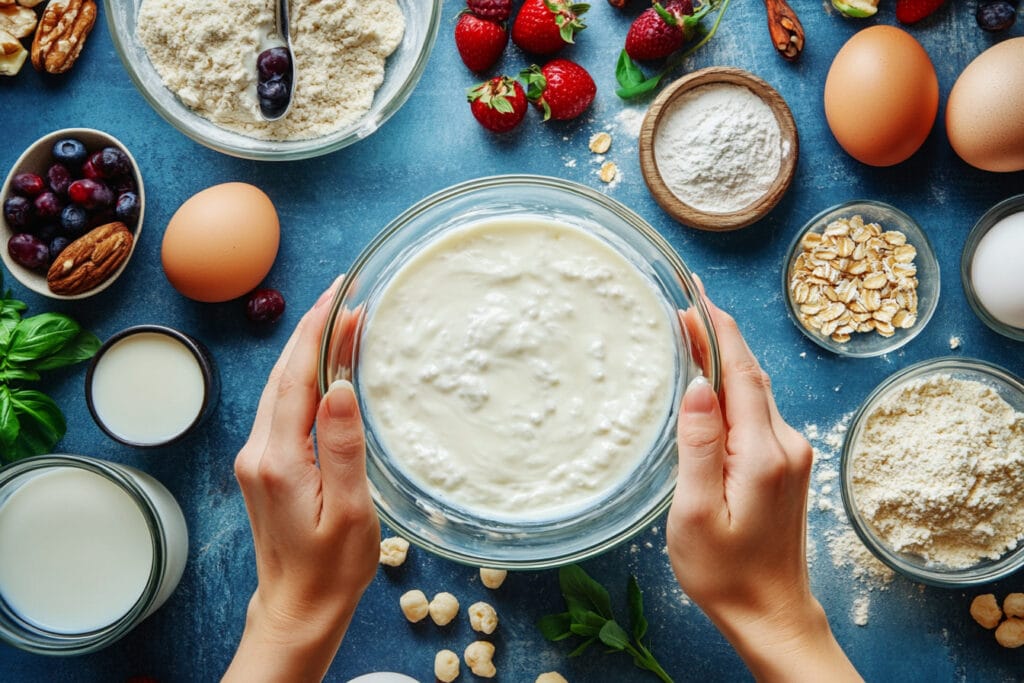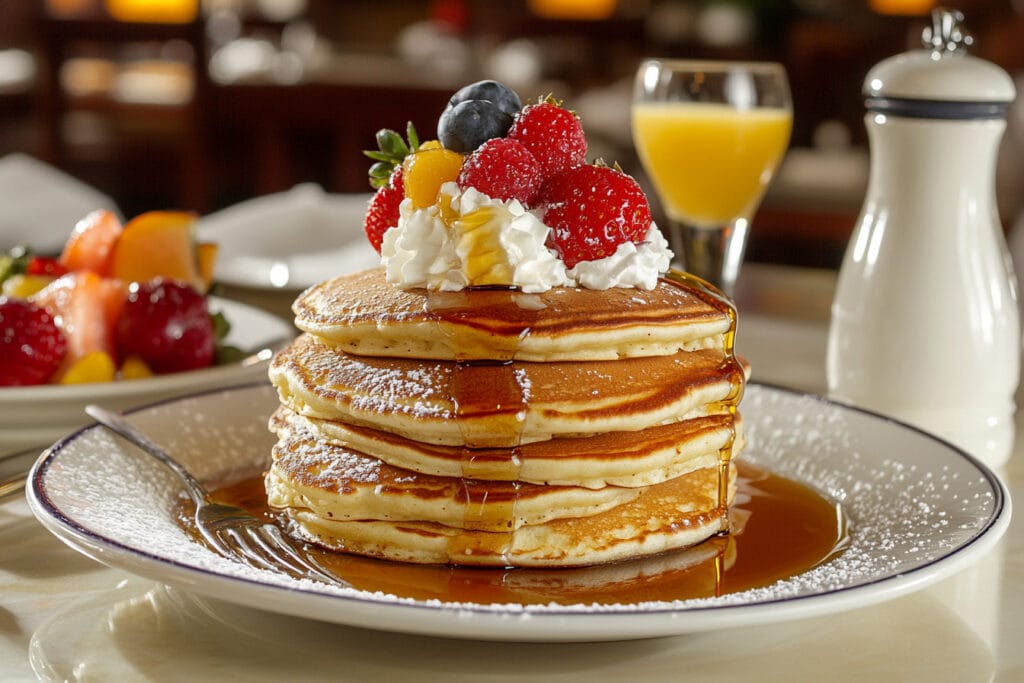
When it comes to breakfast favorites, pancakes and hotcakes often come to mind as two beloved staples that share a striking resemblance. But are hotcake mix and pancake mix the same? This question has intrigued breakfast enthusiasts, bakers, and foodies alike. While the terms are often used interchangeably, subtle differences in ingredients, texture, preparation methods, and even cultural connotations set them apart.
In this comprehensive guide, we’ll explore everything there is to know about hotcake mix and pancake mix. From understanding their origins and core ingredients to comparing their versatility and nutritional values, this article will help you determine whether these two breakfast icons are truly identical or if the differences are significant enough to choose one over the other.
Let’s dive into the world of hotcakes and pancakes, exploring their similarities and differences to answer the ultimate question: Is hotcake mix the same as pancake mix?
Understanding the Basics of Hotcake and Pancake Mixes
What is a Hotcake?
Hotcakes are flat, round cakes that people cook on a griddle or frying pan. They feature a dense, thick texture that differentiates them from pancakes. In certain regions, such as Japan and parts of the United States, people refer to hotcakes as cakes with a slightly richer or heavier consistency.
Breakfast lovers value hotcakes for their ability to remain moist and fluffy, even when cooked thick. Cooks prepare the batter with milk, eggs, flour, and baking powder. Many also enhance the flavor and texture by adding sugar or butter. These qualities make hotcakes ideal for pairing with robust toppings such as honey, butter, or even savory ingredients.
What is a Pancake?
Pancakes, by contrast, are lighter and airier versions of hotcakes. People prepare them in a similar way but make them thinner, which allows for easy stacking with layers of syrup, fruits, and whipped cream. The term “pancake” is widely recognized around the world, especially in the United States and Europe, where it sometimes refers to crepes or flapjacks, depending on regional traditions.
Cooks design pancake batter to create a fluffier texture. The batter uses ingredients similar to hotcakes but usually with less sugar and a thinner consistency. This difference produces the light, airy structure that defines pancakes. Their versatility makes them a favorite breakfast option, easily pairing with either sweet or savory toppings.
The Common Ingredients
Both hotcake and pancake mixes rely on a base of similar foundational ingredients. These include:
- Flour: The primary ingredient in both mixes, usually all-purpose flour, provides structure to the batter. In some cases, alternative flours like whole wheat or gluten-free options are used.
- Leavening Agents: Both mixes typically use baking powder or baking soda to help the batter rise during cooking, resulting in a fluffy texture.
- Sugar: A small amount of sugar is included in both mixes to enhance the sweetness, but the level of sweetness can vary.
- Salt: Added in small quantities, salt enhances the overall flavor profile by balancing sweetness and intensifying other flavors.
- Milk Powder (or Milk): Often included as a dry ingredient or added during preparation, milk provides richness and helps bind the batter.
- Egg Powder (or Eggs): Eggs add structure, moisture, and richness to the batter, ensuring it cooks evenly.
These common ingredients create the soft, pillowy texture that defines both hotcakes and pancakes.
Key Differences in Ingredients
While the core ingredients are similar, there are some notable differences that distinguish hotcake mixes from pancake mixes:
- Density of Ingredients:
- Hotcake Mix: Hotcake mixes are often richer and denser, containing slightly more sugar and sometimes additional fats like butter or vegetable oil. This contributes to a thicker, more substantial texture.
- Pancake Mix: Pancake mixes are lighter and typically include fewer fats and sugars, resulting in a thinner and airier batter.
- Flavoring Additives:
- Hotcake mixes sometimes incorporate vanilla extract, honey powder, or even additional dairy fats to create a more robust flavor.
- Pancake mixes focus on a neutral flavor profile, making them more versatile for both sweet and savory toppings.
- Leavening Ratios:
- Hotcake mixes may include a higher proportion of leavening agents (like baking powder), making them puffier and capable of achieving a more pronounced rise.
- Pancake mixes balance the leavening to produce a slightly flatter, more even surface.
Variations Across Brands
Not all hotcake and pancake mixes are created equal, and different brands offer unique takes on these classic breakfast items. For example:
- Japanese Hotcake Mixes: These often contain additional milk powder and sugar to produce an ultra-thick, dessert-like hotcake that resembles a soufflé.
- American Pancake Mixes: Many U.S. brands focus on convenience, offering mixes that require only water to prepare. These tend to be lighter and less sweet.
- Homemade Mixes: Home cooks can easily tweak recipes by adding or subtracting sugar, fats, or leavening agents to create their preferred version of either hotcakes or pancakes.
Differences in Preparation and Cooking
While the ingredients in hotcake and pancake mixes share similarities, the preparation and cooking methods are where distinct differences emerge. These variations directly impact the texture, thickness, and overall experience of eating hotcakes versus pancakes. Let’s explore the unique ways these two breakfast items are prepared and cooked.
Texture Differences
The preparation of hotcakes and pancakes influences their final texture, which is one of the defining factors that set them apart:
- Hotcakes:
- Hotcakes are known for their thick and dense texture. This is achieved by using a batter that is slightly thicker, with less liquid added during mixing.
- The higher sugar and fat content in hotcake batter often results in a moist, slightly chewy interior that holds its structure well.
- After cooking, hotcakes tend to feel heavier and more substantial on the palate, making them ideal for those who enjoy a heartier breakfast option.
- Pancakes:
- Pancakes are lighter and airier, thanks to a thinner batter with more liquid incorporated during preparation.
- Pancake batter creates a fluffy, delicate texture due to the balance of leavening agents, which trap air bubbles during cooking.
- Once cooked, pancakes are softer and more tender, making them perfect for stacking and pairing with light toppings like whipped cream and fresh fruit.
Cooking Techniques
Both hotcakes and pancakes are cooked on a flat surface, such as a griddle or frying pan, but there are notable differences in the techniques used:
- Hotcakes:
- Cooks often serve hotcakes individually to emphasize their thick, cake-like appearance. Typically, they top them with butter, syrup, or savory ingredients like fried eggs and bacon to create a more filling meal. Moreover, hotcakes are ideal for those who enjoy a hearty breakfast.
- In some cultures, especially in Japan, people enjoy hotcakes as a dessert. They add toppings like whipped cream, berries, or custard to enhance their richness and turn them into an indulgent treat. Therefore, hotcakes work well as both a breakfast and dessert option.
- Pancakes:
- Pancakes, on the other hand, usually appear in stacks, which showcases their thinner, lighter texture. Many people drizzle syrup over each layer or add fruit for extra sweetness, making them visually appealing as well. Furthermore, pancakes are great for creating a customizable breakfast experience.
- For a classic breakfast spread, cooks often plate pancakes alongside sausages, scrambled eggs, or hash browns. As a result, pancakes become a versatile option that pairs well with various sides, offering something for everyone at the table.

Serving and Presentation
The way hotcakes and pancakes are served further highlights their unique characteristics:
- Hotcakes:
- Pancakes usually appear in stacks, showcasing their thinner, lighter texture. Many drizzle syrup over each layer or add fruit for extra sweetness.
- For a classic breakfast spread, cooks often plate pancakes alongside sausages, scrambled eggs, or hash browns, making them a versatile option for any table.
- Pancakes:
- Pancakes are commonly served in stacks, which is a hallmark of their thinner, lighter texture. Each layer can be drizzled with syrup or layered with fruit for added sweetness.
- Pancakes are more versatile in presentation and are often plated with additional sides like sausages, scrambled eggs, or hash browns for a classic breakfast spread.
Nutritional Differences Between Hotcake and Pancake Mixes
Fat and Sugar Levels
The fat and sugar content in hotcake and pancake mixes can influence both their taste and nutritional profiles:
- Hotcakes:
- The batter for hotcakes is often richer due to the inclusion of extra sugar, butter, or powdered milk. This results in a higher fat content, typically around 4-7 grams of fat per serving.
- The added sugar also makes hotcakes sweeter. They usually contain around 6-10 grams of sugar per serving, making them a slightly indulgent option.
- Pancakes:
- Pancake mixes generally contain less fat, around 2-4 grams of fat per serving, making them a lighter choice.
- Sugar levels in pancake mixes are usually lower, averaging 3-6 grams of sugar per serving, though this can vary depending on the brand.
The Role of Toppings and Add-Ons
The nutritional profile of hotcakes and pancakes is heavily influenced by the toppings you choose:
- Hotcakes:
- Common toppings like butter and syrup can add 100-200 calories per serving. If served with savory toppings like eggs or bacon, the calorie count increases further.
- For a healthier twist, consider adding fresh fruit, Greek yogurt, or a drizzle of honey instead of traditional butter and syrup.
- Pancakes:
- Pancakes are often topped with maple syrup, powdered sugar, or whipped cream, adding 50-150 calories depending on the quantity used.
- Healthier alternatives include unsweetened applesauce, sliced bananas, or a sprinkle of nuts to boost fiber and protein content.
Versatility and Use of Hotcake and Pancake Mixes
Making Other Recipes with Hotcake Mix
Hotcake mix, with its denser and slightly sweeter profile, serves as an excellent base for a variety of non-traditional recipes. Here are some creative ways to use hotcake mix:
- Hotcake Muffins:
- Hotcake mix can easily double as a muffin base. Add milk, eggs, and mix-ins like blueberries, chocolate chips, or nuts to create fluffy, dessert-like muffins.
- These muffins are perfect for a grab-and-go breakfast or a quick snack.
- Hotcake Doughnuts:
- Hotcake mix can be used to make baked or fried doughnuts. The thicker batter produces soft, cake-like doughnuts that can be glazed or sprinkled with powdered sugar.
- This is a fun way to enjoy hotcake batter with a crispy twist.
- Hotcake Bread:
- Hotcake mix can be transformed into quick bread by adding ingredients like mashed bananas, cinnamon, or vanilla. This results in a moist, dense loaf perfect for breakfast or tea time.
- Hotcake Cookies:
- For a unique treat, hotcake mix can serve as the base for soft, chewy cookies. Combine it with sugar, butter, and chocolate chips to bake delicious cookies with minimal effort.
- Hotcake Pizza Crust:
- Believe it or not, hotcake mix can be repurposed as a pizza crust. Mix it with water and oil to form a dough, then roll it out, bake, and top with savory ingredients like cheese, vegetables, or meats.
Practical Tips for Using Hotcake and Pancake Mixes
Maximizing the versatility of these mixes requires a few practical tips:
- Adjusting Batter Consistency:
- To create a thicker batter for waffles or doughnuts, reduce the amount of liquid.
- For a thinner batter suitable for crepes, increase the liquid slightly.
- Customizing Flavor:
- Add vanilla extract, cocoa powder, or spices like cinnamon to personalize the flavor.
- Incorporate mix-ins like chocolate chips, fruits, or nuts to make the batter more exciting.
- Storage and Freshness:
- Store unused hotcake or pancake mix in an airtight container in a cool, dry place to maintain freshness.
- For prepared batter, refrigerate and use within 24 hours to ensure optimal flavor and texture.

Frequently Asked Questions
Is hotcake mix interchangeable with pancake mix?
Yes, you can often use hotcake mix and pancake mix interchangeably since both share similar ingredients and preparation methods. However, it is important to note a few key considerations. For instance, hotcake mix typically produces a thicker and denser result, while pancake mix creates lighter and fluffier cakes. Therefore, if you prefer a pancake-like texture using hotcake mix, you may need to add more liquid to thin the batter. On the other hand, to make a hotcake-like result using pancake mix, reducing the liquid or adding an extra egg can help. For additional tips, check out this guide on making your own hotcake mix at home, which explains how to achieve different textures and flavors.
Which is fluffier: hotcakes or pancakes?
In general, pancakes are fluffier than hotcakes. This is because pancake batter has a thinner consistency and incorporates a balanced amount of leavening agents that trap air during cooking. As a result, pancakes develop a light, airy texture. Conversely, hotcakes are denser and thicker because of their richer batter, which includes more sugar and fats. If you’re interested in mastering texture variations, refer to the perfect steak egg and cheese bagel recipes for insights on complementary breakfast items.
Can you make waffles with either mix?
Absolutely! You can make waffles using either hotcake or pancake mix with a few adjustments. For instance, waffles require a slightly thicker batter to hold their structure in a waffle iron. If you are using pancake mix, simply reduce the liquid to thicken the consistency. Hotcake mix, on the other hand, already has a denser batter, making it particularly well-suited for waffles. For more breakfast inspiration, explore recipes like these avocado tacos for guilt-free indulgence.
What are the regional variations of hotcakes and pancakes?
Hotcakes and pancakes have unique variations around the world, reflecting different cultures and preferences:
- Japanese Hotcakes: Known for their ultra-thick, fluffy, and dessert-like texture, often served with whipped cream, berries, or syrup.
- American Pancakes: Thin, fluffy, and served in stacks with butter and maple syrup, with popular variations like buttermilk or banana pancakes.
- European Pancakes (Crepes): Thin and pliable, filled with sweet options like Nutella or savory fillings such as ham and cheese.
- Latin American Hotcakes: Often served with toppings like dulce de leche or caramel for a sweet, decadent treat.
Explore more breakfast variety ideas, including topping inspirations, in the hotcake mix recipe guide.
Are hotcakes healthier than pancakes?
The answer depends on the specific mix and how they are prepared. Hotcakes tend to contain more sugar and fat, making them slightly higher in calories. However, their dense texture can make them more filling, which may help prevent overeating. On the other hand, pancakes are typically lighter and contain fewer calories and less sugar, depending on the brand and recipe. To balance health and indulgence, consider pairing your breakfast with nutritious sides, as highlighted in this guilt-free avocado taco recipe.
Can you add mix-ins to hotcake and pancake batter?
Yes, adding mix-ins to the batter is a great way to customize your hotcakes or pancakes and enhance their flavor. Here are some popular ideas:
- Sweet Mix-Ins: Chocolate chips, blueberries, strawberries, bananas, or shredded coconut.
- Savory Mix-Ins: Chopped herbs, cheese, diced ham, or crispy bacon.
- Healthy Additions: Chia seeds, flaxseeds, or protein powder. Grated carrots or zucchini for a veggie-packed breakfast.
Experimentation is key—dive into this step-by-step guide to hotcake recipes to discover new mix-in and topping ideas.
Can you use water instead of milk in the batter?
Yes, water can replace milk in both hotcake and pancake batter. However, this substitution can slightly affect the flavor and richness. Milk adds creaminess and moisture to the batter, which enhances the taste and texture of the final dish. If you use water, the batter may feel lighter, but the pancakes or hotcakes will still turn out delicious. For alternative ideas, explore this comprehensive guide to hotcake preparation to tailor recipes to your dietary needs.
Conclusion
Hotcake and pancake mixes play a central role in kitchens worldwide, providing a quick and delicious way to start the day. While these two breakfast staples share many similarities, their differences make each one unique. Hotcake mixes create thicker, denser cakes with a slightly sweeter profile, making them perfect for hearty breakfasts or dessert-like presentations. In contrast, pancake mixes produce lighter, fluffier results that work well for stacking, customizing, or pairing with a variety of toppings.
By understanding the ingredients, preparation methods, cooking techniques, and nutritional profiles of these mixes, you can make an informed choice that suits your preferences. If you enjoy a cake-like texture and a rich flavor, hotcakes might be your go-to option. On the other hand, if you prefer light and airy pancakes with endless topping possibilities, pancake mix offers unmatched versatility.
You can also experiment with these mixes in creative ways. Transform them into muffins, waffles, crepes, or savory dishes to expand your breakfast repertoire. Popular brands like Morinaga, Krusteaz, Kodiak Cakes, and Bisquick cater to a range of preferences, from protein-packed blends to indulgent dessert-like versions.
Ultimately, whether you choose hotcakes or pancakes, both bring warmth and comfort to the breakfast table. Take the time to experiment with toppings, textures, and recipes, and enjoy the process of creating your perfect meal. With these mixes in your pantry, you’ll always have a delicious and satisfying start to your day.
